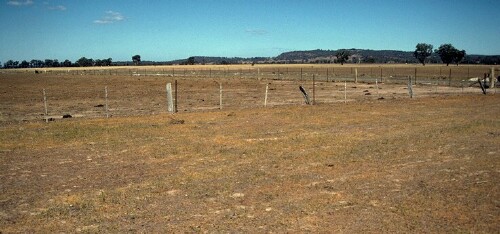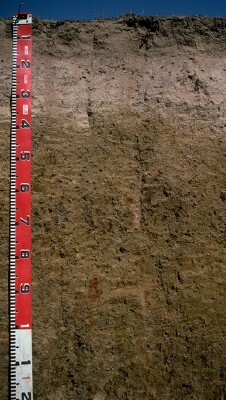NE1
| Group: Chiltern Landcare Group | Australian Soil Classification: Bleached-Sodic, Eutrophic, Yellow CHROMOSOL |
| Northcote Factual Key: Dy 3.43 | Great Soil Group: solodic soil |
| General Landscape Description: Old alluvial plain. The original vegetation included Yellow Box (Eucalyptus melliodora) and Red Box (E. polyanthemos). | |
 NE1 landscape |
Soil Profile Morphology:
Surface Soil
| A1 | 0-10 cm | Dark brown (10YR4/3); fine sandy loam; hardsetting and massive surface condition; firm consistence dry; pH 6.0*; clear and smooth change to: |  NE1 profile |
| A2 | 10-35 cm | Light yellowish brown (10YR6/4) conspicuously bleached (10YR8/2d); coarse loamy sand; massive; firm consistence dry; pH 5.3*; clear and wavy change to: | |
| Subsoil | |||
| B21 | 35-60 cm | Light yellowish brown (10YR6/4) and brownish yellow (10YR6/6) mottles; light clay (sandy); weakly structured; very strong consistence dry; contains a few (3%) semi-hard manganese concretions; pH 7.7; gradual change to: | |
| B22 | 60-90 cm | Light yellowish brown (10YR6/4) with brownish yellow (10YR6/6) mottles; light clay (sandy); moderate coarse sub-angular blocky structure; very strong consistence dry; contains a few (5-10%) hard manganese nodules and very few (2%) quartz crystals; pH 7.5; gradual change to: | |
| B23 | 90+ cm | Brown (10YR5/3) with yellowish red (5YR5/8) and brownish yellow (10YR6/6) mottles; medium clay; moderate structure; very firm consistence moist; contains manganese stains and pockets of quartz; pH 8.3. | |
| *20 replicates taken from the paddock. | |||
Key Profile Features:
- Strong texture contrast between the surface (A) horizon and clay (B) horizons.
- Conspicuously bleached subsurface A2 horizon.
- Sodic subsoil.
- Hardsetting surface soil with a high fine sand content (45%).
Soil Profile Characteristics:
Horizon | pH | Salinity Rating | ||
Surface (A1 horizon) | moderately acid | very low | non-sodic | __ |
Subsoil (B21 horizon) | slightly acid | very low | nearly sodic | none1 |
Deeper subsoil (at 1 m) | moderately alkaline | very low | sodic | strong |

Horizon | Horizon Depth (cm) | pH (water) | pH (CaCl2) | EC 1:5 | Exchangeable Cations | |||
Ca | Mg | K | Na | |||||
meq/100g | ||||||||
A1 | 0-10 | 6 | 5 | <0.05 | 2.3 | 0.6 | 2.7 | 0.1 |
A2 | 10-35 | 5.3 | 4.4 | <0.05 | 1 | 1.5 | 0.1 | 1.7 |
B21 | 35-60 | 7.7 (6.8) | 5.6 | <0.05 | 4.8 | 1.9 | 0.4 | 0.4 |
B22 | 60-90 | 7.5 | 0.09 | 4.3 | 2.2 | 0.5 | 0.5 | |
B23 | 90+ | 8.3 | 0.08 | 4.7 | 5.8 | 0.7 | 1.7 | |
Horizon | Horizon Depth (cm) | Exchangeable Aluminium mg/kg | Field Capacity pF 2.5 | Wilting Point pF 4.2 | Coarse Sand (0.2-2.0 mm) | Fine Sand (0.02-0.2 mm) | Silt (0.002-0.02 mm) | Clay (<0.002 mm) |
A1 | 0-10 | <10 | 20.4 | 4 | 23 | 45 | 16 | 16 |
A2 | 10-35 | 15 | 17.8 | 4.7 | 28 | 43 | 20 | 8 |
B21 | 35-60 | <10 | 22.5 | 14.7 | 23 | 27 | 13 | 35 |
B22 | 60-90 | |||||||
B23 | 90+ |
Management Considerations:
Surface (A) Horizons
- The surface has a low overall nutrient status (based on the sum of the exchangeable basic cations) and a low level of total nitrogen and organic carbon.
- The surface soil is hardsetting and has a high fine sand content (45%). Upon wetting and drying the surface soil sets hard and will be difficult to work and may become "powdery" when worked in a dry condition. Cultivation of such soils when wet may result in surface sealing upon drying. Tillage should be minimised and stubble retention/pasture rotations practised to improve organic matter levels. Organic matter will assist in improving surface soil structural condition.
- The conspicuously bleached A2 horizon indicates that periodic waterlogging may occur. This horizon has low fertility and is likely to become "soupy" when worked in a wet condition (as is evident by strong dispersion occurring after remoulding). The A2 horizon is strongly acid but exchangeable aluminium levels are relatively low based on laboratory data available.
Subsoil (B) Horizons
- The subsoil is nearly sodic at this site and disperses slightly in water (after 20 hours) (strongly after remoulding). This is likely to restrict water and root movement through the profile. Some areas in the paddock are, however, sodic in the upper subsoil (ESP ranges from 4-13) and are more likely to suffer from restricted water and root movement.
- The subsoil has a moderate overall nutrient status (based on the sum of the exchangeable cations).
Comments from Landholder:
- The white subsurface layer becomes soupy in winter.
- Ripping is not worthwhile as the rips close up within a month.
Notes
Profile described by Mark Imhof, Paul Rampant and Sonia Thompson (15/3/95).


